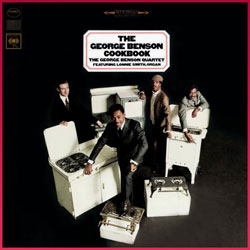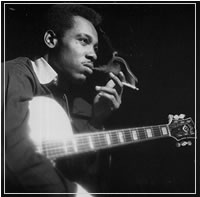Recently, a student of mine asked me if
I had ever done any George Benson transcriptions. Initially, I
had to answer, "No." But, after thinking a moment, I realized that I had
actually transcribed one of his solos, and the melody statement which
precedes it, many years ago prior to my move to New York City in 1970.
So,
I went into my old, very old, notebooks and finally located a rather
primitive looking transcription of "Bossa Rocka" which appears
on George's 2nd recording as a leader for Columbia Records from 1966 when
he was only in his early twenties. That LP, now a CD, was titled "THE
GEORGE BENSON COOKBOOK" and featured a group with organist Lonnie
Smith and baritone sax great, Ronnie Cuber. During some of
my recent travels I decided that I would look over the original work I
did because it did NOT look accurate AT ALL. When I finally had some time
to compare what I had written out over 30 yrs. ago with what I now heard,
well, if I had been giving myself a letter grade for this work, it would
have been an 'F' without question! There must have been an error
in virtually every single bar. Wow, horrible!!! Anyway, enough of this,
let's get right to discussing just how wonderful a player George Benson
is. When I finally had some time
to compare what I had written out over 30 yrs. ago with what I now heard,
well, if I had been giving myself a letter grade for this work, it would
have been an 'F' without question! There must have been an error
in virtually every single bar. Wow, horrible!!! Anyway, enough of this,
let's get right to discussing just how wonderful a player George Benson
is.
"Bossa Rocka" is really the first transcription
offered at KHAN'S KORNER where the melody statement itself is presented
for study. I chose to do this because the way George plays here is a perfect
blend of letting the single notes speak while portions of chord melody
are added for warmth and color. If you listen as you watch the written
music go by you should hear that George is phrasing in a beautifully laid-back
style. Each phrase being played romantically on both sides of the beat.
It's wonderful to hear his feel and touch, which I believe was just done,
at least in parts, with his thumb. There's a very 'fleshy' sound to many
of the phrases. When someone is playing in such a laid-back manner it
can make writing it out a little difficult but I believe that we must
write out the 'intent' of the phrases and indicate that it was played
with feeling and interpretation. Another reason for presenting this tune
is that it gives the feeling of being a 'standard.' It has a classic form
sense about it, but, it's not really an [A][A'] form, though it's
certainly close to it. You'll notice that the 1st 8-bars of [A]
and [A2] are identical but there the similarities end. [A]
contains 12-bars and [A2] has 18-bars which is really an odd number
of bars, but, it all feels very organic. When George does offer a chord
voicing, they are pretty fundamental but each is perfect for the spot
in which it appears with there being more chordal activity in [A2]
as the composition builds. So, just to repeat, pay attention to these
elements: [1] George's beautiful melodic phrasing, so very relaxed and
laid-back and, [2] How and where he flavors the single notes with chord
melody. Again, all of this is beautifully done and shows a maturity far
greater than his years might indicate. At this young age, George Benson
was ALREADY an artist and a master of his instrument. It's terrifying to think
that he only got better, and better with each recording.
One of the reasons I chose to offer this
solo for study, aside from the fact that I just happened to have it lying
around, was that George plays so melodically and relaxed. IF you are familiar
with the two Columbia recordings(the first being, "IT'S UPTOWN" with
the GEORGE BENSON QUARTET)then you'd know how incredibly facile a
player he was then....tremendous chops, energy, and a very adventurous
and fearless spirit. So, that said, to hear him play in such a 'casual'
fashion is wonderful, and gives the student, of any age, a chance to hear
and see just which notes are essential to a jazz improvisation over some
very 'standard' chord changes. On virtually every V7(alt.) chord which
precedes a resolution to a Imaj7 or im7, George employs the b9 pitch.
Examine bars 6, 8, and 10 of [A]; and bars 6, 8, and 16 of [A2]. On virtually every V7(alt.) chord which
precedes a resolution to a Imaj7 or im7, George employs the b9 pitch.
Examine bars 6, 8, and 10 of [A]; and bars 6, 8, and 16 of [A2].
Rhythmically, you should listen for his
usage of various triplet ideas especially as the tune is played over a
bossa nova feel, which is an even-8th note feel, as opposed to swing.
The usage of triplet groupings only accentuates the laid-back nature of
his approach to this tune. You might want work on adding to your own playing
the triplet grouping where George leaves OFF the 1st 8th-note and then
plays the next two. You hear examples of this in bars 1, 4, 6, and 10
of [A]; and bars 13, 15, and 16 of [A2].
George Benson's solo on "Bossa Rocka" has
all the elements to make a classic solo: tone, touch, feel, great phrasing,
and beautiful note choices. One just could not ask for much more. Perhaps
the point I've been trying to make is this: In an ideal world, if one
can make the interpretation of a melody sound improvised and then play
an improvised solo which is so melodic that it seems composed
then I believe that you will have something truly wonderful happening.
It is an ideal for which to strive! And this is exactly what George Benson
has done on "Bossa Rocka." Again, one must bow to the amazing polish George
had already attained at around 23 yrs. old. How very rare this is! Like
one of his heroes, Wes Montgomery, years of service in an organ trio(George's
apprenticeship was with Brother Jack McDuff) had to have been the
best training ground of all. I can think of no better way to begin the
21st Century than to salute one of our greatest talents, George Benson.
Happy New Year everyone!!!
[Photo of George Benson by Francis Wolff, Englewood Cliffs, New Jersey,
April 7th, 1967.]
|

